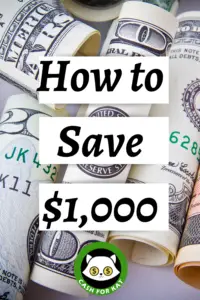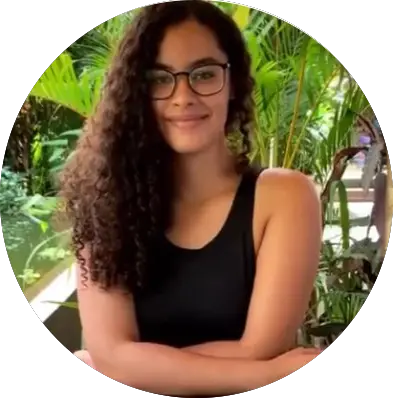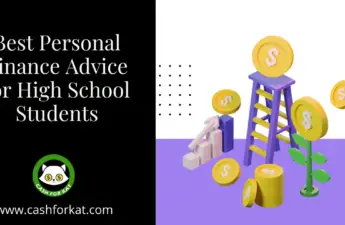
Are you ready to stop wondering how to make $1,000 and learn the easy steps I took to get there?
Saving $1,000 is nowhere near as hard as it used to be. In fact, I was able to save my first $1,000 while making $15 an hour as a full-time college student in the Bay Area!
After that, I focused on making it happen month after month. And it got easier every time! In this post, you will find 10 actionable steps that will help you save $1,000 in a month.
If you enjoy posts like this, be sure to subscribe!
How to Save $1,000 in a Month
Let’s cut to the chase, if you want to know how to save $1,000 in a month, then you need to master these key areas.
- Reducing Expense
- Increasing Earnings
- Sticking to a Budget
If you are able to decrease your expenses by $500 and increase your earnings by $500, then you will be able to save $1,000 without having to earn all of that money!
You can find the combination of expense reduction/ earnings increases that makes the most sense for your lifestyle. The easiest way to do so is by figuring out a budget and sticking to it!
How to Save $1,000 a Month using SMART goals
I love using SMART goals when planning my personal, professional, and financial goals. These goals help create objectives that are realistic and push you to accomplish them within a certain amount of time.
SMART stands for:
- S- Specific
- M- Measurable
- A- Attainable
- R- Relevant
- T- Time-bound
If your goal is to save $1,000 a month, then you’ve already fulfilled everything on this list! Your goal is Specific (save), Measurable ($1,000), Attainable ( thanks to this post!), Relevant (to your goals), and Time-bound (in a month!).
Now that you know the basics of how to save $1,000 in a month, let’s get into the 10 actionable steps that will help you get there.
1. The Key to Saving $1,000 a Month begins with having a disposable income.
What is disposable income and how will it help me save $1,000?
Disposable income is the fancy way of saying you have more money than you need for your necessary expenses. All that money people spend on movies, eating out, shopping, etc. is typically disposable income.
If you do not have a disposable income, no guide in the world can help you save $1,000 a month. That is just math.
How to calculate your disposable income
You can find your disposable income by adding together your necessary recurrent expenses. This includes your rent, food budget (NOT including eating out!), utilities, transportation costs, and debt payments. You can include any other bills you are obligated to pay such as your phone, internet, etc.
Now take however much you are earning and subtract these expenses. Whatever is leftover is your disposable income!
An example of calculating the disposable income you need to start saving $1,000 a month
Let’s say you make $2,000 each month. If you spend $600 on rent, $400 on food,$200 on utilities/other necessities, and $100 on transportation, then your disposable income is $700.
That means you have $700 each month that you can save, invest, or spend! Unfortunately, most people will spend all of that money. However, if you decide to save it then you only need to earn $300 more to save $1,000 a month!
Even if you decided to spend $200 on fun activities, you are still halfway to saving $1,000.
Once you’ve figured out your budget, you can apply an of the following steps that make the most sense for you.
2. Don’t just increase your income, create multiple streams of income!
Fun Fact: Almost every single millionaire has more than one stream of income. In fact, the more money you have, the harder it is not to!
Even in college, I focused on increasing my income through a variety of methods. I would work at call centers or retail stores that offer additional pay beyond my hourly rate for being good at my job.
I would pick up one-time side projects whenever possible. I started investing my money and began receiving small dividend payments before I was 20. If you are interested in learning more about how I build multiple income streams be sure to subscribe!
Saving $1,000 a month was only possible for me because I had 3 different income streams!
The first month I was able to save $1,000 was mainly thanks to a $700 commission check from my part-time job.
I also scored a one-day gig working at a booth handing out fliers at my university on behalf of a local credit union, they paid me $100. The rest of the money came from saving part of my hourly paycheck and my dividend payouts on stocks in my retirement accounts.
There are many ways to piece together enough money to save $1,000 a month. If you need help getting started, you might want to begin with my post on How to Make $100 a Day. I cover everything from participating in market research focus groups to teaching English online!
I promise that it is easier than you think to make money online. Did you know that there are YouTubers and Twitch streamers that have accumulated a net worth of over 25 million dollars? Making a few extra bucks can be as simple as filming yourself doing something you love and posting it!
3. Baby Steps: No one starts out saving $1,000 a month immediately
The truth is, maybe you won’t be able to start saving $1,000 by next month. And that’s ok! What you should be focusing on is creating habits and behaviors that help you get there. Keep increasing your disposable income and you will be saving money without even realizing it!
Even if you aren’t able to increase your disposable income, check out how much money you would have if you save just $2 hour at a 40-hour a week job.

4. Automate it and forget.
One of my favorite ways to save money without thinking about it is by automating your savings. You can have your bank automatically transfer a set amount into your savings account each month.
My personal favorite personal finance hack is having the money go to a brokerage account or savings account at a different bank so that I can’t accidentally spend the money.
After you’ve set this up, just try not to think about it so that you are not tempted to spend the money. Don’t even think about it for a month or two and you’ll be amazed when you check back in a month!
There are apps that can help you save automatically!
You could use an automatic savings app like Digit or an automatic investing app like Acorns to get you started!
Digit is great because it analyzes your spending and sneakily saves small, unnoticeable amounts for you throughout the day. Acorns is similar, except it rounds up the cost of your purchases and invests your change for you!
5. Plan your savings AND your expenses
Most people aren’t surprised to learn that they need to budget in order to save $1,000 in a month. What most people don’t realize is that it’s even more beneficial to keep track of what days you earn money and what days you spend money.
I recommend adjusting your bill due dates to one or two days after you get paid from your main job. By doing this, you give the bank time to process your check so that money is in your account.
You are also able to take care of your necessary bills before you have a chance to spend your paycheck. By the way, this is a good time to automate any savings that you can commit to not touching!
Do not develop the “treat yourself!” mentality on payday. If you have the urge to spend your paycheck as soon as you get it, take yourself grocery shopping and by a pint (beer or ice cream, I don’t judge).
6. Utilize 90% of your windfalls
Since we are on the topic of not getting excited and spending all your money, be sure to save 90% of your windfalls!
If you would like to learn more personal finance terms like windfall, geographic arbitrage, ROI, etc. be sure to subscribe to CashforKat!
I send out a monthly newsletter that shares money-saving tips, popular articles, and more!
What is a windfall and how can it help me with saving $1,000 a month?
A windfall is any money that comes your way that you weren’t expecting. Common windfalls include birthday money, Christmas money, that dollar you found on the ground, and the $25 company raffle you won.
For saving purposes, I even include money that is expected but not a part of my normal income. Examples would include my tax refunds, bonus/commission checks, recycling money, etc.
Since this money was not included in your budget to pay for necessities, that means it is disposable income. Since it is an unplanned disposable income, you should easily be able to save 90% of it without thinking.
But we all like a little fun, so I pocket the 10% to do with as I please. To save money, you should also have some fun or you risk going on a spending binge.
7. Make it fun to save!
Create a challenge to make saving more exciting. If you have a likeminded friend, see who can save more in a week/month!
You can even challenge yourself to increase your savings rate every month. I liked to create a little reward system for myself based on how well I committed to each day.
For each day that I saved $5 or more, I would place a dollar into my fun money jar. If you do this every day for a month, you get to use the jar to spend the $30 however you’d like!
If you don’t accomplish this, then you have to save all the money and start again next month. Alternatively, you can keep however much money you saved in the jar as an added incentive to hit your goal next month!
If you would like to be a part of our money-making community and be notified of our next savings challenge, be sure to subscribe!
8. Cut out the Crap
No, I’m not just telling you to stop bullshitting yourself! One of the best ways to help you save $1,000 EVERY month is by adopting a minimalist mindset. Once you focus on what you actually need in your life, you stop spending money on things that clutter up your home.
Do you really need another pair of $100 shoes? Or would you rather save $75 and spend $25 on a paint and sip night in the city with your friends? Maybe the shoes will bring you long term joy every time you put them on. In that case, buy them! If not, think about all the other things you could have done with that money.
Since we are on the topic, you should also take the time to re-evaluate your recurrent expenses as well. Corporations have gotten really good at tricking you into adding things to your plan or signing up for upgrades you don’t even need! Can you downgrade your Netflix subscription or ditch your mobile contract?
Once you’ve developed this mindset, you might want to go through and see what useless items you have accumulated over the years. Instead of throwing them out, sell them! I easily made $200 when I sold random items in my apartment before quitting my job to travel the world at 23.
You don’t need to wait for a move or drastic life change to start purging your place of your junk and reaping the financial rewards of a yard sale!
9. Say Yes to Money
“Kathryn, would you like to pick up an extra shift this Saturday?”
Is this how I would like to spend my Saturday? No. Would my bank account like an extra $50-$100? YES.
“Kathryn, can you work late?”
Am I tired? Yes. Would I like an extra $20 bucks since I’m already here? Yes.
“Kathryn, can you babysit?”
Do I like your kid? I’m not even going to say it. Is watching Dora the Explorer with a five-year-old for 4 hours worth $80? YES.
“Kathryn, if you pack up the recycling you can keep the money.”
Do I want to touch gross things? Ew, no. Was recycling money the easiest $70 I earned throughout my childhood? 1,000 times yes.
My dad and I always have phone calls about the various people we see turning down opportunities like this. Every time, we have one question: Why do people turn down easy money?
Sure, when I’m a millionaire or have a job that pays me $50+ an hour I will probably start declining these offers. Until that day, the answer will always be: “Yes, I would like some money please!”
Since we are on the topic, would you like to learn how to make more money? YES!
10. Before you start saving $1,000 a month… get to know yourself!
I do not mean this in the feel-good “love yourself!” way, though you should focus on that too! What I mean is, think about the life you want to live and where you want to be 5, 15, 30, 60+ years from now.
The generation before often tells youngsters, “Wow, I wish I had paid more attention to personal finance or saved more of my money in my 20’s”. We usually ignore them because we want to live in the now and enjoy the moment, but one day you may regret that choice.
Few people say, “I wish I never saved money!”
So, ask yourself what future you would want. Is it retiring early? Traveling the world? Following your passions?
What small changes can you make in your life to reflect your wants and values? How can you make your money bring you the most happiness and freedom?
Once you know what motivates you, saving $1,000 a month becomes the best activity because it is the tool that helps you live the life you’ve always dreamed of.
As we say in the Financial Independence/ Retire Early community:
“Build the life you want. Then save for it.”
That’s what I’m doing.
Why do you want to save $1,000 a month?
Now that you know how to save $1,000 a month, it is time to start asking yourself what is going to keep you motivated to get there.
Is your motivation:
- Your family
- Your financial future
- To start a business
- To build an emergency fund
- To travel
With these tips, you should no longer be thinking about how to save $1,000 a month. You should be asking, what steps am I taking to save $1,000 this month!
Are you going to use any of these tips? Do you have more ideas for ways to save $1,000 a month? Leave a comment below and be sure to subscribe for updates!
Saving $1,000 a Month by Kat

Kathryn Rucker is a sales consultant and content writer. With 7+ years of sales experience, she is passionate about helping businesses and individuals grow their sales pipelines by improving their online presence.
She has been traveling full-time since 2018 thanks to the location and financial independence she has gained from her business, Kat Rucker Consulting Group. You can connect with her on LinkedIn.
Kathryn Rucker is a sales consultant and content writer. With 7+ years of sales experience, she is passionate about helping businesses and individuals grow their sales pipelines by improving their online presence.
She has been traveling full-time since 2018 thanks to the location and financial independence she has gained from her business, Kat Rucker Consulting Group. You can connect with her on LinkedIn.
Disclosures and Disclaimers: The above references an opinion and is for entertainment purposes only. It is not intended to be investment or insurance advice. Seek a duly licensed professional for your financial planning. Bear in mind that some of the links in this post are ads/affiliate links and if you go through them to make a purchase I will earn a commission (thanks!). Keep in mind that I link these companies and their products because of their quality and not because of the commission I receive from your purchases. The decision is yours, and whether or not you decide to buy something is completely up to you.



Another great post! I love the infographic showing how much you end up with if you save $2 per hour! Never thought of it in that way before.
When I started out on my savings journey, saving £1000 pm seemed like a crazy and unachievable goal. But soon, I was at £500 and then a few months later, I suddenly hit £1000. For me, saving was definitely an addiction and once I got started, I was motivated to increase my contributions by as much as I could.
This is excellent. I often hear that people can’t find money to save but they have no idea how they are spending their money. Cut out the crap is my favourite tip. 😀
I agree, it is one of my favorites too! At the end of the day, you have to make saving a priority or else you will always find excuses not to put money aside!
I really love this article (and the brilliant infographic!). I think that there’s a lot to be said in counting your savings BEFORE your fun spendings – so many people do that the wrong way around.
I’m a huge fan of #2, creating multiple streams of income. Far too many people focus on only one source of income and that puts them in a very vulnerable position. Often it’s easier to increase ones I come to get to the $1000 a month goal than keep cut, cut, cutting.
Thank you! This was my first infographic and I’m glad you found it useful! Saving for future Kat is wayyyy more important and I know I will be thankful that I made it a priority. Thanks for stopping by!
“Even if you decided to spend $200 on fun activities, you are still halfway to saving $1,000.” It’s funny because $200 a month is what I budget for my “fun money” haha. Great article Kat!
Thanks for commenting and proving that it IS possible. I was worried some people might think I was crazy, but I found $200 in fun money to be reasonable even in the Bay Area. The truth is, if you are broke then you should probably be working enough that you don’t even have time to spend your money… which is what my life was like in college!
Exactly. Absolutely love it Kat! Would love to feature you on our blog one of these days as well. 🙂
Thank you! That would be fantastic, I would love to guest post!
Automation is KEY. What you automate you eventually stop missing and cannot forget to do. Over time you will be shocked at how much more you accumulate. If you are investing it, automation supports dollar cost averaging and also is shown to increase average returns
Yes! It is surprising how little automation is overlooked in personal finance. I think it is one of the top things you can do to get your habits in order. You have to remove the human emotion and decrease your reliance on self-restraint to stop yourself from spending every dollar.
Great post Kat!
I thought it would be difficult saving a $1,000 a month a couple of years ago until I realized I had a lot of disposable income that I was just letting sit around in my checkingaccount. *Doh* I quickly changed that by putting that money in a high interest savings account.
Fantastic! High-interest savings accounts are for sure a good way to go! I love it when they offer account opening bonuses too.
Wow! I came here expecting to find a post about being super-frugal and living in a tent basically…
But this is really good advice that normal people can follow!
That’s an amazing achievement, I wish I had your foresight when I was your age!
Thanks! I try to think about what I’ve read a million times and then offer insight that is different than that haha! Blogging is one big exercise in creative writing, which is why I love it so much. I’m glad that you found it more relatable for the average Joe. Thanks for stopping by!
Girl this is a BRILLIANT post! Really well written and shows just how easy it is to do 1k a month. I think most people don’t have this mindset but hopefully reading this will show them that small changes can make a HUGE impact.
All of these things are great steps towards saving that $1000. You should outline some of your monthly expense and show how you find your disposable income.
Thanks for the idea, I will be sure to do so in future posts! My spending habits have changed a bit from when I first started saving $1k a month when I was graduating from college. I am actually based out of Cambodia and running this blog as well as my sales consulting business. Lots to come in future posts!
Great article and the inforgraphic is well-made! I particularly liked the 2 last tips say yes to money and the minimalist/cut the crap one! You make it look easy to save that extra cash. I however take the 50/50 approach with windfalls and bonuses etc.
Thank you, I’m glad you enjoyed the article and infographic! The 50/50 approach works very well too! I think how you use windfalls really depends on how much you are already saving. As with everything personal finance related.. it just depends on your goals and how fast you want to get there!
It is really a great and helpful piece of info. I抦 glad that you shared this useful info with us. Please keep us informed like this. Thanks for sharing.